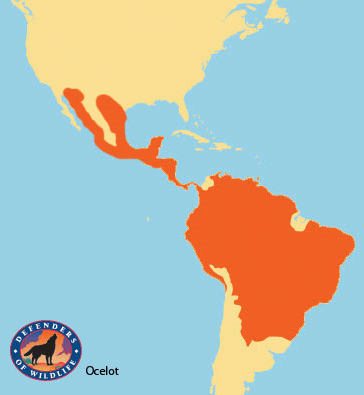
Ocelots (Leopardus pardalis) are medium-sized, spotted neotropical cats whose principal range is Central and South America. They also occur in Mexico, South Texas, and occasionally in southern Arizona.

Juvenile bobcats and mountain lions may be mistaken for ocelots because they, too, are spotted. Another spotted cat is the Margay, but it is much smaller, about the size of a house cat.
Full-grown ocelots have a head and body length of 22 to 38 inches, a tail length of 8 to 10 inches. They can weigh between 18 and 35 pounds. The smaller ocelots tend to occur in the northern part of their range. Ocelots are quite varied depending on location and there are 10 recognized subspecies.
Ocelots have a distinctive bright white spot within black on the back of their ears. Their short smooth body fur is creamy colored on the sides and back and whitish underneath. Both areas sport black spots.
According to the Arizona-Sonora Desert Museum, “Ocelots prefer dense thornscrub, live oak scrub, or riparian areas with an overstory cover.”
Ocelots hunt mainly at night, but may be seen during cloudy or rainy days. Ocelots are solitary animals that maintain territories which are scent-marked by urine spraying and forming dung piles. Males have territories up to 18 square miles. Females have territories of up to 6 square miles. Male territories can overlap several female territories. Social interaction is minimal.
Ocelots feed on a variety of small mammals and birds, as well as some reptiles, amphibians, and fish. They also take young pigs, kids, and lambs, and domestic poultry. Ocelot dens may be a cave in a rocky bluff, a hollow tree, or the densest part of a thorny thicket. Two young are born in late summer or fall. Like other young of the cat family, they are covered with a scanty growth of hair, and the eyes are closed at birth. Gestation has been estimated to last 70-80 days and captive kittens opened their eyes 15-18 days after birth. (Source)
Arizona Game & Fish Department biologists investigate and keep track of ocelot sightings in Arizona. See reports and photos: Feb 5, 2012 in Huachuca Mountains, and another report of the same incident here. Sighting in Cochise County, Dec 2, 2011.
An ocelot was photographed between April 8 and May 21, 2014 near the site of the proposed Rosemont mine in the Santa Rita Mountains according to the US Fish & Wildlife Service. That sighting came two days before the U.S. Forest Service delayed its final decision on the $1.2 billion mine project, in part because of the ocelot. – Arizona Daily Star
Ocelots have been extensively hunted for their fur, kept as pets, and worshiped by ancient Central and South American cultures.
Note to readers:
- Index with links to all my ADI articles: http://wp.me/P3SUNp-1pi
- My comprehensive 28-page essay on climate change: http://wp.me/P3SUNp-1bq
- A shorter ADI version is at https://arizonadailyindependent.com/2013/08/01/climate-change-in-perspective/
- If you like murder mysteries, type the name Lonni Lees (my wife) into Amazon or Barnes & Noble sites to see her novels, a book of short stories, and reviews. For synopses and more reviews of her books see: https://wryheat.wordpress.com/lonnis-murder-mysteries/
